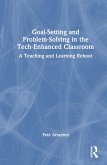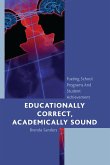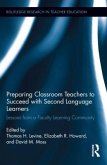Ways of Thinking in Stem-Based Problem Solving
Teaching and Learning in a New Era
Herausgeber: English, Lyn D; Lehmann, Timothy
Ways of Thinking in Stem-Based Problem Solving
Teaching and Learning in a New Era
Herausgeber: English, Lyn D; Lehmann, Timothy
- Gebundenes Buch
- Merkliste
- Auf die Merkliste
- Bewerten Bewerten
- Teilen
- Produkt teilen
- Produkterinnerung
- Produkterinnerung
Taking a future-oriented approach, this book addresses students' ways of thinking in STEM-based problem solving. It provides a rich set of chapters that explore how we can advance important thinking skills in STEM education for K-12 students.
Andere Kunden interessierten sich auch für
![Teaching Media Literacy with Social Media News Teaching Media Literacy with Social Media News]() Roy S WhitehurstTeaching Media Literacy with Social Media News164,99 €
Roy S WhitehurstTeaching Media Literacy with Social Media News164,99 €![Goal-Setting and Problem-Solving in the Tech-Enhanced Classroom Goal-Setting and Problem-Solving in the Tech-Enhanced Classroom]() Pete AthertonGoal-Setting and Problem-Solving in the Tech-Enhanced Classroom163,99 €
Pete AthertonGoal-Setting and Problem-Solving in the Tech-Enhanced Classroom163,99 €![Educationally Correct Academically Sound Educationally Correct Academically Sound]() Brenda SandersEducationally Correct Academically Sound78,99 €
Brenda SandersEducationally Correct Academically Sound78,99 €![Learning to Solve Complex Scientific Problems Learning to Solve Complex Scientific Problems]() David H Jonassen (ed.)Learning to Solve Complex Scientific Problems173,99 €
David H Jonassen (ed.)Learning to Solve Complex Scientific Problems173,99 €![Grammar Toolkit Lesson Plans for Middle School Grammar Toolkit Lesson Plans for Middle School]() Sean RudayGrammar Toolkit Lesson Plans for Middle School173,99 €
Sean RudayGrammar Toolkit Lesson Plans for Middle School173,99 €![Disrupting Secondary Stem Education Disrupting Secondary Stem Education]() Disrupting Secondary Stem Education173,99 €
Disrupting Secondary Stem Education173,99 €![Preparing Classroom Teachers to Succeed with Second Language Learners Preparing Classroom Teachers to Succeed with Second Language Learners]() Preparing Classroom Teachers to Succeed with Second Language Learners120,99 €
Preparing Classroom Teachers to Succeed with Second Language Learners120,99 €-
-
-
Taking a future-oriented approach, this book addresses students' ways of thinking in STEM-based problem solving. It provides a rich set of chapters that explore how we can advance important thinking skills in STEM education for K-12 students.
Produktdetails
- Produktdetails
- Verlag: Taylor & Francis
- Seitenzahl: 280
- Erscheinungstermin: 14. Oktober 2024
- Englisch
- Abmessung: 244mm x 170mm x 18mm
- Gewicht: 662g
- ISBN-13: 9781032520346
- ISBN-10: 1032520345
- Artikelnr.: 70900111
- Herstellerkennzeichnung
- Libri GmbH
- Europaallee 1
- 36244 Bad Hersfeld
- gpsr@libri.de
- Verlag: Taylor & Francis
- Seitenzahl: 280
- Erscheinungstermin: 14. Oktober 2024
- Englisch
- Abmessung: 244mm x 170mm x 18mm
- Gewicht: 662g
- ISBN-13: 9781032520346
- ISBN-10: 1032520345
- Artikelnr.: 70900111
- Herstellerkennzeichnung
- Libri GmbH
- Europaallee 1
- 36244 Bad Hersfeld
- gpsr@libri.de
Lyn D. English is Professor of Mathematics/STEM Education at the Queensland University of Technology, Australia. Her areas of research include mathematics/STEM education, ways of thinking in integrated STEM-based problem solving, mathematical modeling, engineering education, and reasoning with probability and statistics. She is a Fellow of The Academy of the Social Sciences in Australia, and the founding editor (1997) of the international journal, Mathematical Thinking and Learning (Taylor & Francis). Timothy Lehmann is Senior Lecturer in Secondary Mathematics Education at the Queensland University of Technology, Australia. His areas of research are the teaching and learning of secondary mathematics topics including measurement, calculus, discrete mathematics, and the development of computational thinking in mathematics and STEM education.
1. STEM-based Problem Solving in a New Era 2. STEM in a changing world:
'insider' and 'outsider' perspectives 3. Global creative disruption and
implications for STEM-based problem solving and learning 4. STEM ways of
thinking: Elementary grade learners' possibility and adaptive thinking in
STEM-rich contexts 5. The critical role of intuition in problem solving 6.
Nexus for STEM Problem Solving and Transfer Research: Instruction First or
Productive Failure First? 7. Students' Systems Modeling: A Classroom of the
Future 8. Systems thinking in the early grades 9. Systems Thinking Journeys
of Preschool Teachers: A Leverage Point for Problem Solving 10.
Perspectives on Design Thinking within STEM 11. Design-based thinking in
problem solving in technology and across the STEM disciplines 12.
Engineering Design in STEM-based Problem Solving 13. Engineering design
reasoning for conscientious decision-making 14. Critical thinking in STEM
education 15. Critical Thinking in Mathematics and Mathematical Modelling
Related to STEM 16. Computer programming puzzles, mathematics education,
and the culture of learning 17. Computational Problem Solving in STEM
education 18. Challenges in assessing students' STEM-based problem solving
19. Ways of thinking and STEM-based problem solving: Toward the future
'insider' and 'outsider' perspectives 3. Global creative disruption and
implications for STEM-based problem solving and learning 4. STEM ways of
thinking: Elementary grade learners' possibility and adaptive thinking in
STEM-rich contexts 5. The critical role of intuition in problem solving 6.
Nexus for STEM Problem Solving and Transfer Research: Instruction First or
Productive Failure First? 7. Students' Systems Modeling: A Classroom of the
Future 8. Systems thinking in the early grades 9. Systems Thinking Journeys
of Preschool Teachers: A Leverage Point for Problem Solving 10.
Perspectives on Design Thinking within STEM 11. Design-based thinking in
problem solving in technology and across the STEM disciplines 12.
Engineering Design in STEM-based Problem Solving 13. Engineering design
reasoning for conscientious decision-making 14. Critical thinking in STEM
education 15. Critical Thinking in Mathematics and Mathematical Modelling
Related to STEM 16. Computer programming puzzles, mathematics education,
and the culture of learning 17. Computational Problem Solving in STEM
education 18. Challenges in assessing students' STEM-based problem solving
19. Ways of thinking and STEM-based problem solving: Toward the future
1. STEM-based Problem Solving in a New Era 2. STEM in a changing world:
'insider' and 'outsider' perspectives 3. Global creative disruption and
implications for STEM-based problem solving and learning 4. STEM ways of
thinking: Elementary grade learners' possibility and adaptive thinking in
STEM-rich contexts 5. The critical role of intuition in problem solving 6.
Nexus for STEM Problem Solving and Transfer Research: Instruction First or
Productive Failure First? 7. Students' Systems Modeling: A Classroom of the
Future 8. Systems thinking in the early grades 9. Systems Thinking Journeys
of Preschool Teachers: A Leverage Point for Problem Solving 10.
Perspectives on Design Thinking within STEM 11. Design-based thinking in
problem solving in technology and across the STEM disciplines 12.
Engineering Design in STEM-based Problem Solving 13. Engineering design
reasoning for conscientious decision-making 14. Critical thinking in STEM
education 15. Critical Thinking in Mathematics and Mathematical Modelling
Related to STEM 16. Computer programming puzzles, mathematics education,
and the culture of learning 17. Computational Problem Solving in STEM
education 18. Challenges in assessing students' STEM-based problem solving
19. Ways of thinking and STEM-based problem solving: Toward the future
'insider' and 'outsider' perspectives 3. Global creative disruption and
implications for STEM-based problem solving and learning 4. STEM ways of
thinking: Elementary grade learners' possibility and adaptive thinking in
STEM-rich contexts 5. The critical role of intuition in problem solving 6.
Nexus for STEM Problem Solving and Transfer Research: Instruction First or
Productive Failure First? 7. Students' Systems Modeling: A Classroom of the
Future 8. Systems thinking in the early grades 9. Systems Thinking Journeys
of Preschool Teachers: A Leverage Point for Problem Solving 10.
Perspectives on Design Thinking within STEM 11. Design-based thinking in
problem solving in technology and across the STEM disciplines 12.
Engineering Design in STEM-based Problem Solving 13. Engineering design
reasoning for conscientious decision-making 14. Critical thinking in STEM
education 15. Critical Thinking in Mathematics and Mathematical Modelling
Related to STEM 16. Computer programming puzzles, mathematics education,
and the culture of learning 17. Computational Problem Solving in STEM
education 18. Challenges in assessing students' STEM-based problem solving
19. Ways of thinking and STEM-based problem solving: Toward the future








